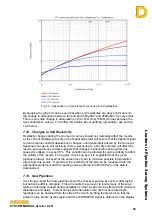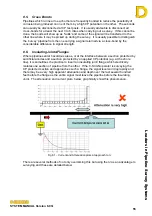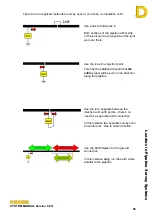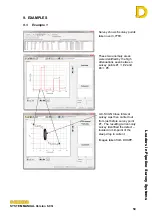
Leaders in Pipelin
e Survey Systems
C
C
C
-
-
-
S
S
S
C
C
C
A
A
A
N
N
N
2
2
2
0
0
0
1
1
1
0
0
0
SYSTEM MANUAL Version 6.03i
51
7.6. Minimum Distance Between Survey Points
Unless a pipeline is in extremely poor condition, it is not generally advisable to take
attenuation measurements at less than 50ft intervals, because the possible signal errors
are of a similar size to the signal loss on a well protected pipeline over such a short
distance. The attenuation readings obtained would thus be virtually meaningless. This
does not apply when the Surveyor is using the ‘halving’ technique to narrow down the
section in which an anomaly lies, as here large local differences in attenuation are being
sought, which will be greater than ambient signal loss on a well protected pipeline.
7.7. Reading Accuracy
The accuracy of the readings obtained is generally in the range +/- 2% but this can be
affected by a number of factors: depth of pipe, strength of signal, the presence of large
faults, field distortion due to other pipes or buried structures close by, etc. In tests, using a
signal level between 90 and 140 mA, and with minimum local distortion, at depths down to
10ft, the depth reading was within 2% 65% of the time and within 5% 100% of the time. At
depths between 10ft and 15ft, readings were within 2% 20% of the time, within 5% 50% of
the time and within 10% 100% of the time.
7.8. Close Interval Surveys
To locate specific faults, the suspect section should be narrowed down to 50-150ft. This
will either be done by using the halving technique or by taking attenuation readings at
closer intervals in areas commonly associated with faults (see 6.3.3). The Operator
should then take readings of current only at intervals of 10-15ft over the suspect section
using the Close Interval Mode described in section 6.8.2. These readings will be stored in
a special format. The faults will be located where there is a steep fall in current level, and
the precise position will usually be close to the mid-point on the steepest slope. If readings
are taken at intervals smaller than 10-15ft, the signal errors will produce a ‘saw-tooth’ plot
which could make it more difficult to identify the anomaly site. For more information on
how to complete a
close interval
survey, refer to section 6.8.2
7.9. Repeat Surveys
Much of the benefit of the signal attenuation survey system arises from the speed and low
comparative cost with which a general survey can be carried out. These benefits become
more marked in repeat surveys of lines that have already had a C-SCAN survey. Repeat
surveys of selected sections can be carried out at more frequent intervals using the
downloaded data or print-out to identify those sections where deterioration is most serious
or is advancing most rapidly so that they can be dealt with in good time. The download or
print-out itself provides a record of a survey having taken place at a particular date, in a
form increasingly being demanded by the regulatory authorities.
















































